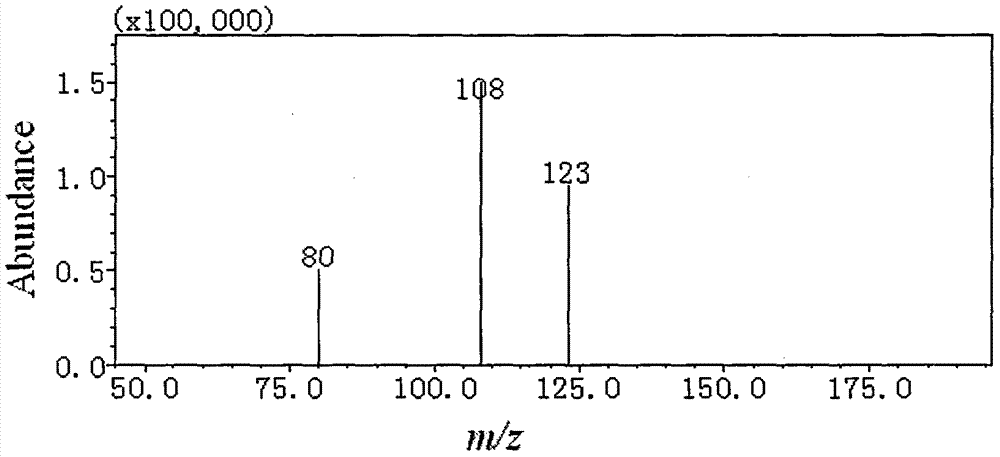Determination method of p-aminoanisole and p-nitroanisole residues in soil
A technology of p-aminoanisole and p-nitroanisole, which is applied in the field of analysis and detection, can solve problems affecting the reproducibility and accuracy of test results, high desorption temperature, hardening, etc., and achieve high accuracy and low Detection limit, effect of reducing interference
- Summary
- Abstract
- Description
- Claims
- Application Information
AI Technical Summary
Problems solved by technology
Method used
Image
Examples
Embodiment 1
[0036] Using p-aminoanisole and p-nitroanisole as analytes, the detection of p-aminoanisole and p-nitroanisole in soil was carried out. Place the collected soil samples on tin foil, spread them flat, dry them in an oven at 40°C, grind them in a mortar, pass through a 60-mesh sieve, and mix them evenly; take 40g of uniform samples and mix them with 10g of pre-dried quartz sand Mix thoroughly at a weight ratio of 4:1, take 0.50 g of the mixed homogeneous sample and place it in two thermal desorption tubes, seal both sides with an appropriate amount of glass wool, compact the sample, and stick the copper mesh to the glass wool two times. Secondary sealed thermal desorption tubes, capped, record numbers S1 and S2, to be tested;
[0037] Take several standard soil samples of the same type, mix them with pre-dried quartz sand in the same proportion as the samples, take 0.5g of mixed standard samples and place them in a thermal desorption tube, seal both sides with an appropriate amo...
Embodiment 2
[0043]This embodiment is the addition and determination of p-aminoanisole and p-nitroanisole standard substances in the sample. Take the sample number S1 described in Example 1, place it in the thermal desorption tube, seal both sides with an appropriate amount of glass wool, compact the sample, and seal the thermal desorption tube with a copper mesh close to the glass wool for the second time. Add 5 μl of 100 μg / ml p-aminoanisole and p-nitroanisole mixed standard solution at the far end, that is, add 0.5 μg of standard substance, blow dry the solvent nitrogen, seal both ends, and record the number as S3, to be tested;
[0044] Take several standard soil samples of the same type, mix them with pre-dried quartz sand in the same proportion as the samples, take 0.5g of mixed standard samples and place them in a thermal desorption tube, seal both sides with an appropriate amount of glass wool, and compact the samples , use the copper mesh close to the glass wool to seal the therma...
Embodiment 3
[0047] Place the collected soil samples on tin foil, spread them flat, dry them in an oven at 40°C, grind them in a mortar, pass through a 60-mesh sieve, and mix them evenly; take 40g of uniform samples and mix them with 10g of pre-dried quartz sand Mix thoroughly at a weight ratio of 4:1, take 0.50 g of the mixed homogeneous sample and place it in two thermal desorption tubes, seal both sides with an appropriate amount of glass wool, compact the sample, and stick the copper mesh to the glass wool two times. Secondary sealed thermal desorption tubes, capped, record numbers S4 and S5, to be tested;
[0048] Take several standard soil samples of the same type, mix them with pre-dried quartz sand in the same proportion as the samples, take 0.5g of mixed standard samples and place them in a thermal desorption tube, seal both sides with an appropriate amount of glass wool, and compact the samples , use the copper mesh close to the glass wool to seal the thermal desorption tube for ...
PUM
 Login to View More
Login to View More Abstract
Description
Claims
Application Information
 Login to View More
Login to View More - R&D
- Intellectual Property
- Life Sciences
- Materials
- Tech Scout
- Unparalleled Data Quality
- Higher Quality Content
- 60% Fewer Hallucinations
Browse by: Latest US Patents, China's latest patents, Technical Efficacy Thesaurus, Application Domain, Technology Topic, Popular Technical Reports.
© 2025 PatSnap. All rights reserved.Legal|Privacy policy|Modern Slavery Act Transparency Statement|Sitemap|About US| Contact US: help@patsnap.com



